Part A: Short report on industry talks/ visits/ lectures and workshops
Throughout the Photography Industry Experience Module and my interactions within the photography industry, I have gained valuable insights and knowledge about various aspects of this dynamic field. One of the most fascinating aspects of the module was the exploration of different photography specializations. Engaging with professionals within the industry was an invaluable experience. Through workshops, lectures, talks, and visits, I had the opportunity to interact with industry professionals such as Matt Martin from Photobook Cafe, Lee, the owner of the Rapid Eye Darkroom, Kira Zimkley, the Head of Photography and Digitisation at the Victoria and Albert Museum, and Nick Dunmar, a professional photographer and Business and Legal Advisor of the AOP and other professionals who generously shared their expertise, experiences, and creative processes. These interactions provided me with practical insights and a deeper understanding of the current trends and challenges in the industry.
Short Report on Photobook Cafe Visit.
The Photobook Cafe was the first industry interaction visit for the group. It is a creative project housed in a delightful and cosy space. The café features shelves adorned with a diverse collection of photobooks from artists worldwide, the majority of which are self-published. It is worth noting that all the books are available for viewing and not for sale. Visitors can select a photobook from the shelves, settle into a comfortable space, and immerse themselves in the visual narratives captured within the pages. This concept encourages a relaxed and interactive atmosphere, fostering a sense of community and appreciation for the art form.


What is unique about the place, is the Gallery which is situated on the basement floor of the Cafe.
Except for exhibitions, the Gallery can be used for a wide range of purposes including photo shoots, and different other events, which is an excellent chance to showcase artistic creations. The PBC host a large collection of Photographic zines, which can be bought online for £10 each, to support the Community. Also, Workshops are offered for those who want to learn how to create zines and art books, and to understand further the biding methods like Saddle, Sections, French, Swiss & Japanese. The workshops are run by PBC curator Matt Martin.


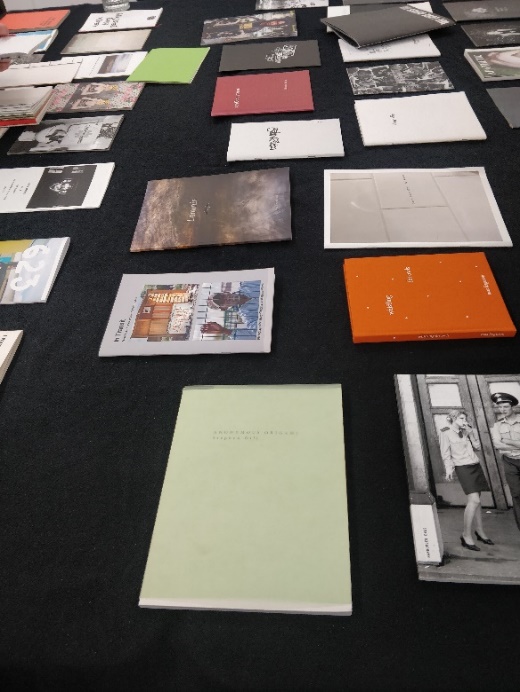
The great chance was to have an incredibly productive conversation with Matt Martin, as a result for us to increase valuable insights around the industry. Matt is a photographer, zine maker, and curator. He has worked in the photography industry for over 15 years, producing workshops, talks and exhibitions. He shared his involvement within the industry, ideas, plans, investments, and sustainability of the business.
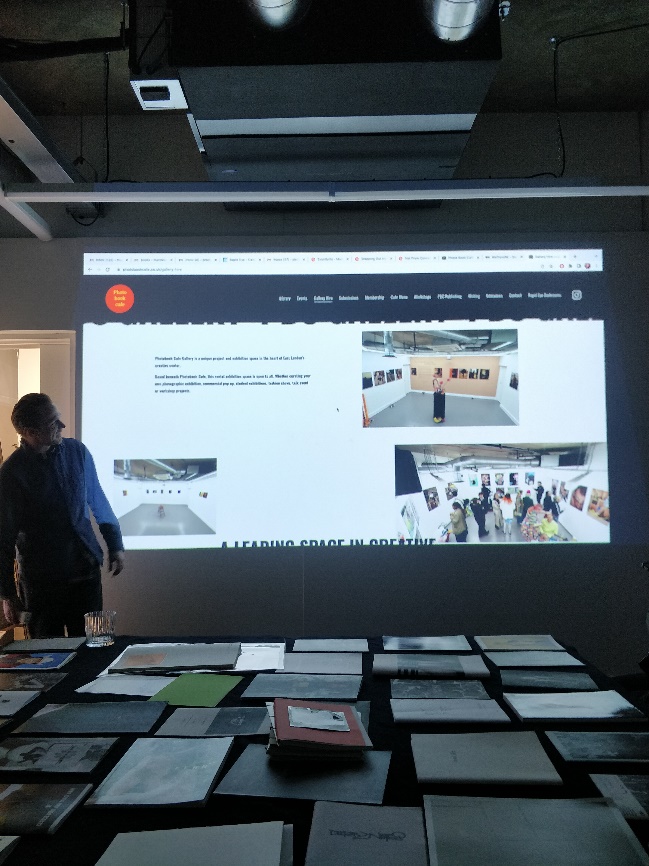 Matt mentioned the first Exhibition organised in the Cafe Gallery named ‘BEST IN BLOOM’. It was an Exhibition fundraiser to support new space. The exhibited artworks were donated by 64 photographers, with the topic of Flowers and Nature. The works were printed as Digital C-Types by Rapid Eye Darkroom and sold for £100 each. All raised money went towards the renovation, painting and lighting of the new gallery, as well as organising workshops, the library, and the reading room.
Matt mentioned the first Exhibition organised in the Cafe Gallery named ‘BEST IN BLOOM’. It was an Exhibition fundraiser to support new space. The exhibited artworks were donated by 64 photographers, with the topic of Flowers and Nature. The works were printed as Digital C-Types by Rapid Eye Darkroom and sold for £100 each. All raised money went towards the renovation, painting and lighting of the new gallery, as well as organising workshops, the library, and the reading room.
Another project mentioned is the ‘Stray Light’ is the Photobook Cafe’s first collective zine project. The zine was handmade at Photobook Cafe, in an edition of 100 and sold for £10 each.
Matt also runs The Photocopy Club, a submission project which supports photographers and collectors through a series of Xerox exhibitions, workshops, talks, and events. All works must be printed on a photocopier in Black and White colour.
One of the self-published Matt’s Photocopied books is Cornish Xerography: A Study of Land and Sea – 2023. The work is a study of the Cornish land and Seascape around the area of Lands’ End, Cornwall. The book is handmade by the artist and printed using a Black and White Xerox machine.


Useful links:
Photo Book Cafe
4 Leonard Circus, EC2A 4DQ
OPEN 8 – 9.00 Monday – Friday / Saturday 10 – 9 pm & Sunday 10-4 pm
Photo Book Café Home (photobookcafe.co.uk)
Matt Martin
Matt Martin (@luckygoldteeth) • Instagram photos and videos
The Photocopy Club
Short Report on the Rapid Eye Darkroom Visit
Next, we went to 79 Leonard Street where the Rapid Eye Darkroom is situated. Is an affordable darkroom and film processing facility based in Shoreditch, it’s a place for renting equipment for photographers, where they can experiment with different techniques and ideas.
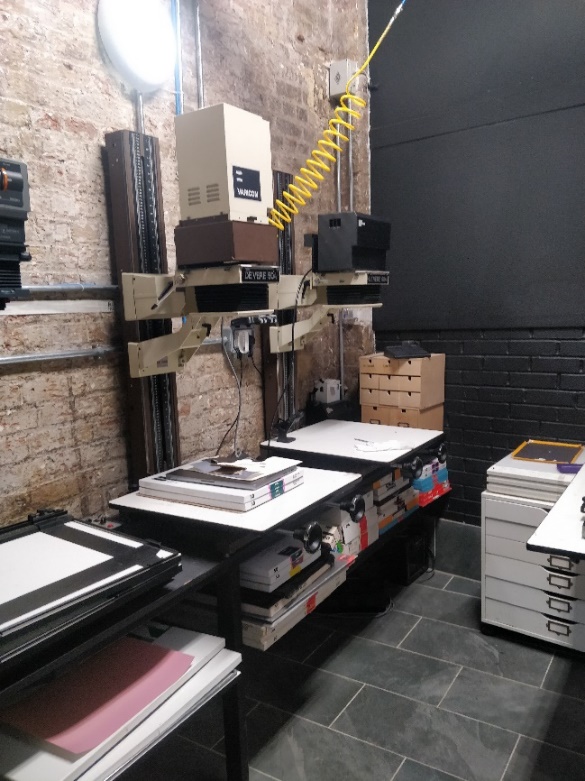 We had a great conversation with Lee, the owner of the business. Lee gave us a tour around the premises and introduced us to all the facilities and workstations of the place.
We had a great conversation with Lee, the owner of the business. Lee gave us a tour around the premises and introduced us to all the facilities and workstations of the place.
Lee studied photography at Tycoch College Swansea and then at Bournemouth and Poole Art School after college he won a business grand that allowed him to start the Rapid Eye Darkrooms in 1996. A darkroom facility has a ‘do-it-yourself’ approach and provides professional film processing and printing.
It is a three-floor spacious place divided into individual professionally equipped rooms and spaces for individual work. Over the Darkroom has grown into a strong community of photographers who create unprecedented-quality images which you will find in the best galleries, magazines, and books around the world.
 The Rapid Eye provide such Rental resources as Dip and Dunk Film Processing and Film scanning, Digital and Hand Printing, and different consumable supplies like film and photo paper which are available both online and in-store.
The Rapid Eye provide such Rental resources as Dip and Dunk Film Processing and Film scanning, Digital and Hand Printing, and different consumable supplies like film and photo paper which are available both online and in-store.
 The Dip & Dunk processing method is a traditional print in the darkroom which you can be rented, or a Rapid Eye’s skilled production member can create a superb handprint, tailored to specific requirements.
The Dip & Dunk processing method is a traditional print in the darkroom which you can be rented, or a Rapid Eye’s skilled production member can create a superb handprint, tailored to specific requirements.
The Dev Scan & Print is a film processing, scanned and machine print on digital C-Type matt or gloss paper. A digital C-type print is made when the digital image is exposed to traditional light-sensitive photographic paper.
High-resolution scanning stations across 35mm, 120mm, 5×4, and 10×9 and print scans including A3 Print scanner station Hire Booth 1, Imacon Film Scanner Station 1, Noritsu Roll Film LS-600 Scanner Station for 35mm, are available.
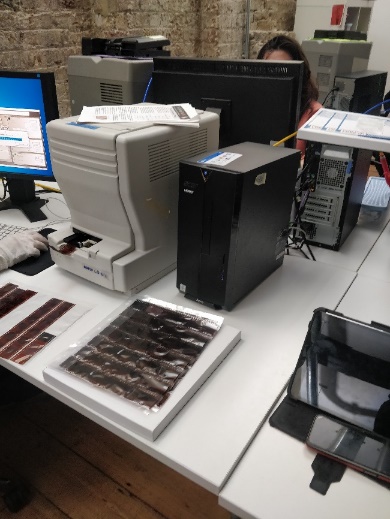
 The Rapid Eye offers classes and workshops. The classes are conducted to get anyone started in the darkrooms or receive more advanced knowledge. It is necessary to take fundamental courses before being granted access to the darkrooms.
The Rapid Eye offers classes and workshops. The classes are conducted to get anyone started in the darkrooms or receive more advanced knowledge. It is necessary to take fundamental courses before being granted access to the darkrooms.
Anyone Join the Rapid Eye Club Membership, which provides discounts on all Rapid Eye products, from processing, film, scanning, handprints and more. All students have been offered FREE membership and discounts.
Useful links:
Rapid Eye Darkroom
79 Leonard Street, London, EC2A 4QS
DARKROOMS: Mon-Fri 9am – 6pm
A short report on the Photography and Digitisation Department of Victoria and Albert Museum (V&A) Visit.
 Victoria and Albert Museum (V&A), located in South Kensington, London, is the world’s largest museum of decorative arts and design. Founded in 1852, its extensive collection includes ceramics, furniture, fashion, glass, jewellery, metalwork, photographs, sculpture, textiles, and paintings. Like many museums, the V&A is increasingly prioritizing digital access to its collections.
Victoria and Albert Museum (V&A), located in South Kensington, London, is the world’s largest museum of decorative arts and design. Founded in 1852, its extensive collection includes ceramics, furniture, fashion, glass, jewellery, metalwork, photographs, sculpture, textiles, and paintings. Like many museums, the V&A is increasingly prioritizing digital access to its collections.
In today’s advanced technological era, museums are placing great importance on digitisation. This is done to safeguard their valuable collections from decay and to enhance the accessibility of the museum’s artefacts. When digitising heritage items, it is crucial to ensure that they are captured only once, minimizing handling and the risk of damage. The goal is to obtain high-resolution, sharp images that accurately represent the artefacts.
The V&A museum has three dedicated photo studios equipped with high-end photographic equipment to accomplish this. Additionally, plans are underway to set up another spacious room as an object studio for larger artefacts. By using digital technologies, the museum is able to record, document, and, in some instances, even recreate works that are threatened by environmental hazards or other disasters.
During our visit, we had the privilege of meeting Kira Zimkley, the Head of Photography and Digitisation at the Victoria and Albert Museum. Kira kindly guided us through the Photography department and its Photo studios. Kira introduced us to some of the museum’s accomplished photographers, including Kevin Percival, George Eksts, and Sarah J Duncan.
We were engaged in a fruitful discussion about their careers and their journey to becoming full-time employees at the V&A. Furthermore, we explored the essential skills required for photographers working with museum heritage objects. This demanding task necessitates a specific set of skills to ensure proper handling, preservation, and documentation of the invaluable artefacts. Attention to detail is important when working with museum objects. Museum photographers meticulously examine and document the objects, capturing their details, textures, and imperfections with accuracy. Proficiency in studio lighting is crucial for proper illumination, minimising glare, reflections, and shadows.
The use of medium format cameras, such as Phase One, is preferred due to their ability to capture high-resolution images with exceptional detail. Proficiency in post-processing software, such as Capture One and Photoshop, is also essential. Understanding colour principles and techniques is necessary to accurately represent the artefacts in the final images.
The Photography Department at the V&A consists of six photographers and a digital engineer assistant, primarily engaged in object photography for documentation purposes—the methodical recording of the collection items.
Overall, our visit to the Victoria and Albert Museum provided valuable insights into the meticulous world of photography and digitisation in the context of museum heritage objects. We gained a deeper understanding of the skills required, the technologies employed, and the importance of preserving and documenting these remarkable artefacts for future generations.



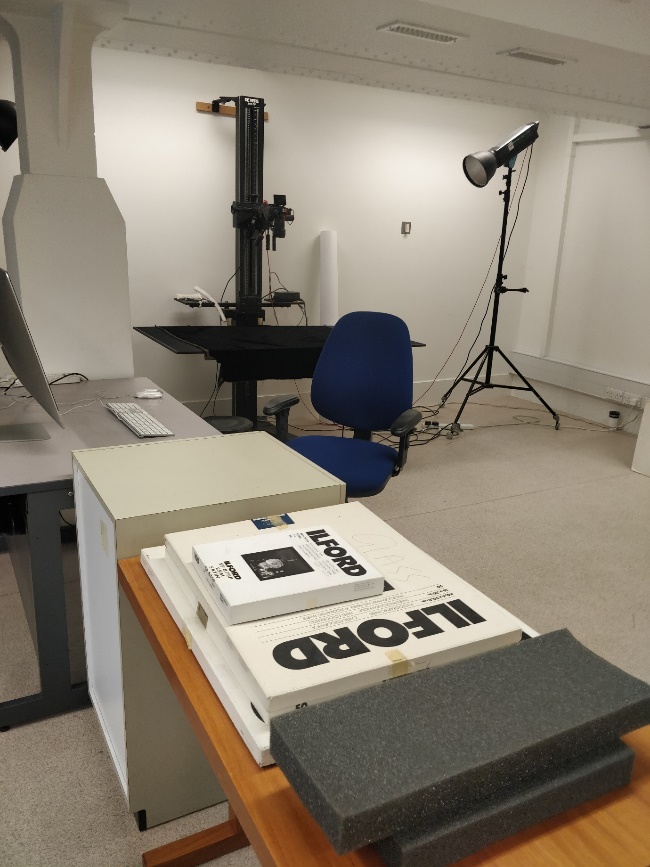
The photographers at the V&A museum use digital cameras, specifically brands like Phase One and Sony. Opting for digital cameras allows for greater flexibility compared to analogue ones, it has huge benefits in terms of lighting conditions, colour accuracy, lens correction capabilities, and various other aspects. Additionally, the lens used in the camera plays a crucial role the right lens is a key factor in achieving optimal results.
Photography Department offers the following services:
1. Object Photography Documentation: The aim of documentation photography is to document using methodical records of a collection of items, focusing on presenting the most accurate and authentic depiction of the object.
2. Object Photography Publication: The main aim of a publication photograph is to disseminate its contents to a wider audience. also to produce creative photographs of collection items for use in promotional and social media campaigns.
3. Flat Object Digitisation includes scanning of negatives, flat copy digitisation of books, paintings, prints, etc., and high-resolution tiled photography of large flat items such as tapestries, frescos, and paintings.
4. Documentary Photography: Documenting the V&A institutional history by photographing objects installs in the gallery or taking behind-the-scenes images of various conservation projects.
5. Contemporary Collecting objects, materials, and stories from the recent past or present-day events that represent culture in its current form.
6. Reflectance Transformation Imaging (RTI): RTI is a computational photographic method that captures a subject’s surface shape and colour. When multiple pictures are taken from a fixed location but with varying lighting angles, they can be merged to create an RTI that provides a highly precise record of an object’s surface. Each RTI resembles a single, two-dimensional photographic image.
The virtual lighting dome centred around a virtual clock, is used to acquire imagery for Reflectance Transformation Imaging (RTI) © Drawn by John Vallender © Historic England
7. X-Ray: Working closely with conservation science V&A has been conducting X-ray analyses of objects for many years. X-ray transmission radiography is a non-destructive technique, one of the most recognisable approaches, that is frequently employed to explore and authenticate works of art.

8. Photogrammetry, a technique that involves capturing numerous images of an object from different angles and merging them to generate a three-dimensional model. A digital camera can be used with a combination of specialised software to construct a 3D replica of the photographed object.

Digital imagery captured with multiple overlaps can be processed within Structure-from-Motion software, such as Agisoft Photoscan, to create a detailed three-dimensional model © Historic England. Photographed by Paul Bryan
9. Photographic Archive: the Victoria and Albert Museum’s Word and Image Department holds an estimated 750,000 prints, drawings, paintings, and photographs. Department’s entire holdings and making them available online.
10. Training provided to V&A staff members who would like to improve their record photography skills.
Raphael Cartoons digitisation project at the V&A
During my research on the digitization of museum artefacts, I discovered a significant digitisation project that utilised digital technology to capture detailed information about the surfaces of artworks. This project focused on the recording of the Raphael Cartoons, which is considered one of the most important series of paintings from the Italian Renaissance in the UK and is housed at the Victoria and Albert Museum.
In the initial phase of the project, approximately 115 square meters of surface area was digitised using two complementary non-contact methods. The first method employed high-resolution Panoramic Photography, which enabled the recording of both colour and infrared data. The second method involved the use of the Lucida, a 3D laser scanner that utilised non-contact technology to capture the surface of the artwork. The Lucida operated by projecting a moving laser beam onto the artwork’s surface and recorded 3D data in 48 cm x 48 cm ’tiles’.

A prototype of the Lucida 3D Scanner recording the complex surface relief of the Hereford Mappa Mundi © Factum Foundation


V&A digital interactive, showing colour, 3D and infrared detail of the Raphael Cartoon the Death of Ananias. Photo: © Victoria and Albert Museum, London. Courtesy Royal Collection Trust / Her Majesty Queen Elizabeth II 2021
The next step was to capture the colours accurately. The Raphael Cartoon was photographed using flash during the night-time. The camera remained stationary while the flash positions were changed at least 3 times. Numerous photographs were taken and then stitched together to create a composite image.
In the second phase of the process, the final images were edited, merged, and aligned using image-stitching software such as Adobe Photoshop and/or PTGui. As a result, three panoramas were created for each Cartoon: a 3D render (used as a foundation), a colour file, and an infrared file. These stitching operations led to the creation of these panoramas.
The final digital files were subsequently transferred to 3D software like Artcam. This software facilitated the generation of a physical form that accurately replicated the surface qualities of the original Cartoon.
Click here to access the viewers on the V&A website

Recording the colour of the Raphael Cartoons at the V&A using panoramic composite photography © Gabriel Scarpa for Factum Foundation© Gabriel Scarpa for Factum Foundation

Each picture acquired during the panoramic composite photography recording was stitched together © Factum Foundation for the V&A and Royal Collection Trust

Useful links:
V&A South Kensington
Opening times
Daily: 10.00 – 17.45
Friday: 10.00 – 22.00
Admission is free
V&A South Kensington
Cromwell Road
London, SW7 2RL
Kira Zimkley – Head of Photography and Digitisation in Victoria and Albert Museum: https://uk.linkedin.com/in/kira-zumkley-94261ba1
Kevin Percival – Object photographer at the V&A:
https://www.linkedin.com/in/kevin-percival-98270873/
https://kevpphotography.co.uk/projects
Sarah J Duncan – Object Photographer at the V&A: https://www.linkedin.com/in/sarahjduncan/?originalSubdomain=uk
sarah j duncan :: photography (sarahjduncan.com)
George Eksts – Artist and Object Photographer at the V&A :
Muesum (@_muesum_) • Instagram photos and videos
George Eksts (cargocollective.com)
The High-Resolution Recording of The Raphael Cartoons Project:
https://www.factumfoundation.org/pag/1560/the-high-resolution-recording-of-the-raphael-cartoons
Short Report on ‘Image Usage and Copyright and the Implications of AI’ talk with Nick Dunmar
We had an opportunity to be invited to the online presentation by a professional photographer and Business and Legal Advisor of The AOP Nick Dunmur.
One of the most significant aspects of Nick’s session was his ability to provide deep insights into the Copyright topic including guidance on assignments and licencing and other copyright concerns. His session was very informative which allowed us to gain a comprehensive understanding of the subject matter and its implications.
During the meeting, Nick provided a comprehensive overview of the Copyright law in the UK and the Intellectual Property Rights (IPR). Another of the key focal points of Nick’s session was the impact of AI and copyright protection.
The Association of Photographers (AOP) is a not-for-profit membership organisation based in the UK that represents professional photographers, illustrators, and designers. One of the main areas of focus for the AOP is the protection and promotion of copyright for its members.
Copyright law in the UK provides legal protection to creators of original works. such as photographs, literary, artistic, musical, and dramatic works, films, sound recordings, and broadcasts. Copyright law grants the creator of a work exclusive rights to control how their work is used and distributed.
Intellectual Property Rights (IPR) refer to the legal protections.
IPR for photographers typically includes copyright, which is the legal right to control the use and distribution of their work, as well as moral rights, which are personal rights designed to protect their non-financial interests in their work.
In the UK, IPR for photographers are protected by various laws, including the Copyright, Designs and Patents Act 1988, the Trade Marks Act 1994, and the Registered Designs Act 1949.
In the UK, photographers can transfer their rights to their work through an assignment or grant limited rights through a license agreement.
An assignment is a legal transfer of ownership of copyright from the photographer to another person or entity. In return for the transfer of ownership, the photographer is typically paid a fee.
A license, on the other hand, is a legal agreement that grants permission to use a copyrighted work under certain conditions.
There are two types of license agreements – exclusive and non-exclusive.
An exclusive license gives the other party the sole right to use the photograph for the specified purpose or period, and the photographer cannot license the same photograph to anyone else during that time.
A non-exclusive license allows the photographer to license the photograph to multiple parties for the same purpose or period.
Nick in his presentation mentioned the following:
Non-exclusive licence:
-can be issued to many clients,
-photographer no longer needs permission to use,
The client can sue for infringements with written authorisation from the photographer.
Exclusive licence:
-to one client only,
-photographer needs permission to use,
The client can sue for infringements.
Exceptions to Copyright:
-private use
-orphan works
-parody
-employment
-Incidental inclusion
-criticism and review
The implications of AI and copyright protection in the photography industry are very complex.
On one hand, AI technology has made it easier and more accessible for individuals to create and manipulate digital images. On the other hand, AI can also be used to help to protect the copyright of photographers by detecting and preventing unauthorised use of their images.
For example, AI algorithms can be used to scan the internet for unauthorised use of copyrighted images and alert photographers when their images are being used without permission.
However, the use of AI in the creation of images also raises questions about authorship and ownership of the work. For example, if an AI algorithm generates an image, who owns the copyright? Is it the photographer who used the algorithm or the creator of the algorithm?
Useful links:
Nick Dunmur Website: https://www.nickdunmur.com
Association of Photographers: AOP Website
Intellectual Property Office: Intellectual Property Office (IPO)
Design and Copyright Society: DACS (Design & Artists Copyright Society)
The Association of Photographers: Association of Photographers (AOP)
Short Report on Direct Digital Rental Company Visit
Recently, we had the opportunity to visit the premises of Direct Digital. The excursion aimed to provide us with practical insights into the industry of professional photography and filmmaking.


Direct Digital Rental specialises in renting high-end digital equipment, such as cameras, lenses, lighting, and accessories, to professional photographers and filmmakers.
In addition to equipment rental, Direct Digital Rental also offer related services such as digital capture services, colour correction, retouching, and post-production editing. It also offers studio rental services.
During the excursion, we were escorted throughout the Direct Digital premises by Lawrence and Simon Browitt. Lawrence is a Camera Manager, who specialises in managing and maintaining the equipment in the company and Simon Browitt, is the Business Development Manager and Marketing whose responsibilities are to identify and target potential clients, such as production companies, photographers, filmmakers, and event organisers. They provided valuable insights and demonstrated excellent customer service skills. They patiently showed us and explained the operation of various equipment This aspect of the visit emphasised the importance of technical knowledge and the ability to assist clients effectively.
The excursion exposed us to the latest industry trends and innovations in high-end digital equipment that I never have seen before.
Some of the company’s services include hiring a wide range of mirrorless and medium format cameras, high-tech MacBook laptops, a range of workstations, strobe lighting including Profoto, Broncolor, Briese, Elinchrom, constant lighting such as HMI, Tungsten, Kino flow, LED’s, Dedo light. Also, the high-performance flash equipment for photographic shoots including battery generators, reflectors and softboxes and many, many others.
Some of the distinctive innovative equipment that I discovered for myself were:
1. The Flanders Scientific production monitors, are specialised displays used in professional video production.


2. The wide range of cameras, lenses including Canon, Sony, Fujifilm, Nikon and more. The Mirrorless such as Sony a7r, Nikon Z7, or Canon R5 and the Medium Format such as Phase One, Mamiya, and Fujifilm.




3. The Briese Lighting, which is Focus System, is a unique lighting system used in the field of photography and cinematography. It is designed to provide precise and adjustable lighting control. The system revolves around a parabolic reflector, it has a distinctive shape that helps concentrate and control the light output.


4. LED & Fluorescent Lighting such as Astera Titan RGB Kit is specially designed for the Film, Broadcasting and Cinema industries. peak brightness, colours as well as Hue, Saturation and Intensity can be set directly on the tube.
5. The ARRI SkyPanel, is known for its tremendous output and large light aperture.

5. Versatile lighting stands and grips, a wide range of textiles, flags and frames for stills and movie shoots.


6. Range of high-capacity generators, from mobile vehicle generators to portable battery generators.


Also, you can purchase a wide range of consumables such as a variety of paper for backdrops from Colorama, digital storage, LEE lighting filters, tethering products and more.
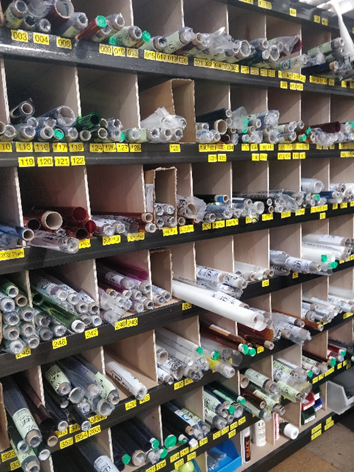

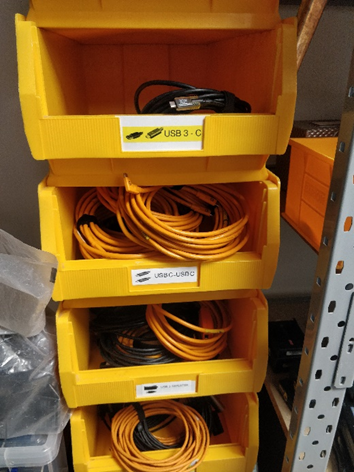
The visit to Direct Digital’s premises was an invaluable experience for us as students. It provided us with practical insights into the world of professional photography and filmmaking, allowing us to explore and interact with high-end equipment. This excursion not only enriched our technical knowledge but also emphasised the significance of excellent customer service.
Useful links:
Direct Digital Rental Website – Camera & Lighting Rental | London & Manchester | Direct Digital (direct-digital.com)
Black Islands Studios – Black Island Studios – Commercial Film Studios in West London
Part B: Individual Work Assignment
Proposal: Future Job Role as a Photographer
My aim, as a professional photographer, is to continue to grow and develop my skills, knowledge, and experience in the industry. I am passionate about photography and have a strong desire to build a successful career in this field. I would like to become a freelance commercial photographer, specialising in advertising and editorial photography. In this role, I would work with clients to create visually stunning images that promote their products or services.
To achieve this, I understand that I need to continue to develop my skills and gain relevant experience in the industry. I plan to achieve this through a combination of formal education, practical experience, and networking.
Research on three Industry Professionals
The three professional photographers who attracted my attention and admiration are Martin Schoeller, Steve Mccury, and Jenna Christina Photography
Each photographer has a unique style and approach to capturing images. They specialise in different genres like portrait photography, fashion, and documentary photography.
1. Martin Schoeller is a renowned photographer known for his distinctive style of portraiture. Schoeller’s unique selling points lie in his ability to capture the essence and character of his subjects through close-up and highly detailed portraits.


Schoeller has worked with a diverse range of clients, including magazines, advertising agencies, and celebrities. His work has appeared in renowned publications such as National Geographic, The New Yorker, Vanity Fair, and TIME magazine. Some of his notable clients include actors, musicians, politicians, and athletes.
Regarding his pricing structure, it is common for photographers of Schoeller’s calibre to have different rates depending on the project’s scope, duration, and usage rights. Factors such as the client’s budget, the intended use of the photographs, and any additional services required (such as post-production editing) can also influence the final price. Typically, photographers like Schoeller will provide a detailed quote or estimate after discussing the project requirements with the client.
Martin Schoeller Website – https://martinschoeller.com/
2. Steve McCurry is a renowned American photographer, freelancer, and photojournalist known for his captivating and iconic images. Born on February 24, 1950, in Philadelphia, Pennsylvania, McCurry began his photography career as a photojournalist, documenting various conflicts and cultural aspects around the world. He gained international recognition for his powerful photographs, particularly for his work in Afghanistan.
One of Steve McCurry’s unique selling points is his ability to create visually stunning and emotionally evocative images. He has a keen eye for capturing intimate moments and telling stories through his photographs. McCurry often focuses on capturing the human condition, cultural diversity, and the resilience of individuals in challenging circumstances.
Throughout his career, Steve McCurry has worked for numerous esteemed clients, including National Geographic magazine. His images have graced the pages of major publications, exhibitions, and galleries worldwide. McCurry’s photographs have been exhibited in renowned museums and galleries, and he has received numerous awards and honours for his contributions to the field of photography.
When it comes to charging clients, Steve McCurry’s fees are typically negotiated based on factors such as the scope of the project, usage rights, and duration of the assignment. McCurry’s assignments can range from editorial and commercial projects to corporate commissions, with fees varying accordingly.


Steve McCurry Website – https://www.stevemccurry.com/
3. Jenna Christina is a family documentary photographer. Her style attracted me because she is focusing on capturing candid and authentic moments of families in their natural environments. She aims to tell the story of a family’s everyday life, capturing real emotions, interactions, and connections.




Her unique selling points revolve around the genuine and unposed nature of the images. Unlike traditional portrait photography, Jenna aims to capture the essence of a family’s dynamics and relationships by observing and documenting their daily routines and activities.
The clients of her business are typically families themselves.
When it comes to charging clients, she has various pricing models depending on the session that includes a specific number of hours or a certain set of deliverables, such as a certain number of edited images. She also offers additional products, such as prints or albums, which are priced separately.
Jenna Christina Photography Website – https://www.jennachristinaphoto.com/
• Reflective Report
The Photography Industry Experience Module provided a comprehensive overview of the industry, including its history, current trends, and various genres and niches within photography. Through this module, I gained a deeper understanding of the technical and creative aspects of photography, as well as the business side of the industry.
Additionally, the module highlighted the significance of professionalism and ethical considerations in the photography industry. I learned about copyright laws, model releases, and the importance of obtaining necessary permissions when capturing and using photographs. This knowledge will undoubtedly guide my future endeavours in the field and ensure that I operate ethically and legally.
Building my website was an exciting yet challenging endeavour. Through this process, I gained practical skills in web development and design, which are valuable in today’s digital age. Initially, I faced difficulties in selecting the appropriate platform and deciding on the layout and structure of my website. However, with the guidance and resources provided during the course, I was able to overcome these challenges.
I focused on creating a clean and intuitive interface that showcased my photography portfolio effectively. This involved careful consideration of colour schemes, font choices, and navigation menus to ensure a seamless user experience. By understanding the principles of web design, I was able to create an aesthetically pleasing website that aligned with my personal brand and photography style.

